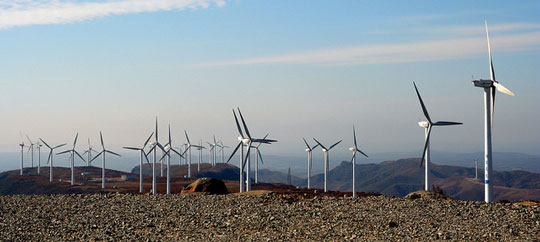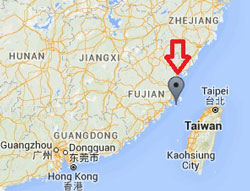
As negotiators enter the crucial final week of the UN-led Paris climate-change conference, much of the cautious optimism is pinned on big changes in China’s real economy.
A strong climate change agreement is now in China’s self-interest, runs the prevailing argument – in large part, thanks to its aggressive investment in, and deployment of, renewable energies like wind power.
But what does that deployment look like on the ground?
A long-overdue announcement late last month sheds some light on the sometimes difficult politics of implementing such ambitious, centrally mandated plans, evident in China’s climate pledge to the UN and likely incorporated into the 13th Five Year Plan from 2016-2020.
On November 25, the Chinese government approved the investment plan for building the country’s biggest ever onshore wind farm. The 400-megawatt (MW) installation will be on Nanri Island, in south-eastern China’s Fujian Province.
 Nanri Island is one of the most abundant sources of wind on China’s south-eastern coast. The site has estimated annual operating hours – the amount of time for which the turbines will generate electricity – of more than 3,700 hours.
Nanri Island is one of the most abundant sources of wind on China’s south-eastern coast. The site has estimated annual operating hours – the amount of time for which the turbines will generate electricity – of more than 3,700 hours.
This shows great potential, in terms of the site’s economic and climate benefits, compared with an average of below 2,000 hours for other Chinese wind farm projects.
Barriers to planning and approving wind farms in China
However, like many onshore wind energy projects in China, Nanri has had a difficult birth, and the approval of its investment plan came very late.
The process suffered a protracted and painful negotiation process between political and economic stakeholders across multiple bureaucratic units, from the oceanic administration to the military and coastguard and fishing and shipping industries, to name but a few.
This is sadly not unusual.
In 2010, China’s National Energy Administration launched a landmark onshore wind energy public procurement programme, which included four projects with a total 1,000-MW capacity in eastern China’s Jiangsu Province. None of these four projects were built, as most of investors became lost in the maze of bureaucratic procedures that ensued, and were not able to get the necessary approvals from different government agencies.
China’s 12th Five Year Plan (from 2011- 2015) contained a detailed and ambitious roadmap for developing its on-shore wind farms, with the aim of reaching five gigawatts (GW) of on-shore wind capacity by 2015. Current installation, though, stands at 390 MW. China is unlikely to achieve one-tenth of its target by the end of the plan – an unusual embarrassment for central planners in Beijing.
Beyond the ‘vertical fragmentation’ of elite bureaucratic units, the other factor deterring investment has been the uncooperative manner of local governments, who believe that on-shore projects bring limited economic value in terms of tax revenue and local employment.
Technological hurdles are also still high for these projects. There are no industrial standards as yet for the design, inspection, installation, operation and maintenance of onshore wind farms in China.
Facing these uncertainties, few investors or manufacturers have been capable of implementing on-shore projects in China, despite central government support.
In the case of Nanri, however, there might be another reason to hope for its eventual success. Its investor, Longyuan, is a subsidy of Guodian group, one of the biggest Chinese state-owned utilities. For the Nanri project, Longyuan chose German conglomerate Siemens as their partner to supply 4MW turbines. Although no specific technology transfer agreement has been revealed at this stage, the prospect of such transfers might be a reason for Longyuan to choose a foreign turbine supplier.
Still, as negotiators thrash out a climate deal at Paris, Nanri’s approval is a positive signal for investors and policymakers alike.
This article was first published on the Institute of Development Studies website. It is part of our coverage of the COP21 climate change conference.
Image: Mulan Wind Farm by Land Rover Our Planet (Flickr cc-by-nd 2.0)